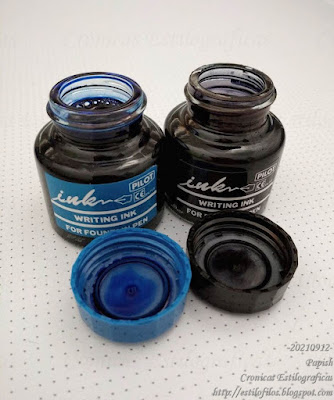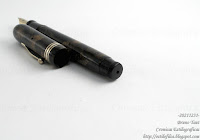There were at least three ink colors manufactured in Thailand—blue, blue-black, and black. I could only get my hands on two of them, and the current analysis is limited to those—blue and black.
The question to answer is obvious—are these Thai inks of the same formulation as those made in Japan?
Smell wise, the Thai inks have a very distinctive phenol odor whereas those made in Japan are almost odor-less. The black ink, though, releases a hint of ammonia.
On paper, both pairs show similar tones. The Thai blue is slightly lighter in color, and the Japanese version occasionally adds some purple sheen. The Thai ink has a higher surface tension.
Re black ink, the Thai one is again slightly lighter and less brilliant than the Japanese ink.
Finally, the chromatography shows that the dye composition is different in both pairs. The differences are bigger in the black inks. But the conclusion is clear—Thai and Japanese inks are different formulations.
Not much can I say about Pilot in Thailand. It started in 1953, and the manufacturing plant was located in Bangkok. The Thai black ink is dated in 2013, and we can assume that the Pilot plant was open until at least that year. As of today, the Pilot Thailand website (http://www.pilotpen.co.th/) is not active, and there is no reference to Thailand in the Pilot Global site.
 Manufacturing date of the Thai black ink--Thai year 2556, which corresponds to AD 2013. Photo courtesy of Papishdama.
Manufacturing date of the Thai black ink--Thai year 2556, which corresponds to AD 2013. Photo courtesy of Papishdama.My thanks to my friend and ink connoisseur Papishdama.
Note (August 2022): It seems that the Thai Pilot was related to the Korean Pilot, a different company than the Japanese one. Korean Pilot is not operating currently.
Chilton Large – Sailor Yama-dori
Bruno Taut
January 12th, 2022
etiquetas: Tailandia, tinta, Pilot
Bruno Taut
January 12th, 2022
etiquetas: Tailandia, tinta, Pilot
















8 comments:
It's surprising. What a difference! Maybe quality control was not good enough at that time in Thailand?
Thank you for sharing. So happy to be of any help.
I just think the formulations are different, and Pilot had no intention of making the same ink everywhere. Health concerns and industrial standards are indeed different between Japan and Thailand.
Thanks for your help and support.
BT
Thailand Pilot was a subsidiary of Korea Pilot.
Thanks, k! That would explain some of my questions. And knowing that Pilot Korea ceased its operations it is no surprise the Thai plant also stopped working.
Thanks again.
BT
Out of curiosity, if you do chromatography tests of the exact ink, how do they look next to each other. Not saying there's anything wrong with the tests you did here. Just wondering what type of variations happen from the same ink, such as the shape in the result.
Thanks, Kakinoki James.
For this text I prepared several chromatographies of each ink, and chose those where the dyes were shown more clearly. When compared side by side those of the same ink you do see the same dyes, although not always equally separated. What you certainly do not see are different dyes (colors) in the rings.
Thanks for passing by and commenting.
BT
Thailand Pilot is a subsidiary of Korea Pilot. So there won't be much information.
Thanks, kt. It was already mentioned.
Cheers,
BT
Post a Comment
Your comments are welcome and appreciated.